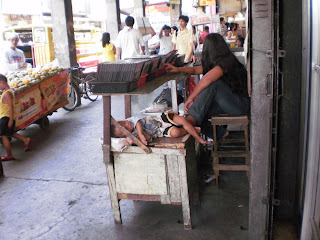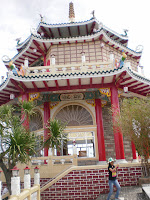These first photos are of Frank and his family. He works in a little area next to his house. Here he is showing us a liahona he has in process.
 This is a carving of a handcart family he is working on. The large block on the right will become the father figure on the left (pulling the handcart).
This is a carving of a handcart family he is working on. The large block on the right will become the father figure on the left (pulling the handcart). Here is a completed handcart family. (On display in one of the offices in the Area Office)
Here is a completed handcart family. (On display in one of the offices in the Area Office) This is a statue Frank did of Joseph and Hyrum Smith.
This is a statue Frank did of Joseph and Hyrum Smith. From Frank's house we walked down a treelined lane to some of the other woodcarvers' homes. We had a parade of children following us everywhere we went!
From Frank's house we walked down a treelined lane to some of the other woodcarvers' homes. We had a parade of children following us everywhere we went! On our walk we passed a group of children under a tree with a vendor selling "colored chicks".
On our walk we passed a group of children under a tree with a vendor selling "colored chicks". Our next stop was in the little village of Paete in Laguna. The village has little alleyways lined with homes and shops.
Our next stop was in the little village of Paete in Laguna. The village has little alleyways lined with homes and shops. We visited Armand and his family in their home. He carves in a little area of their living room. Armand started carving when he was 12. He now works with his father and uncle.
We visited Armand and his family in their home. He carves in a little area of their living room. Armand started carving when he was 12. He now works with his father and uncle. This is Armand and his young family. His wife is due with their third daughter in about 2 weeks (mid-Sept.)
This is Armand and his young family. His wife is due with their third daughter in about 2 weeks (mid-Sept.) Here are some of Armand's carvings. He does beautiful nativity sets and
Here are some of Armand's carvings. He does beautiful nativity sets andreliefs of Mary, Joseph and the baby Jesus.
 This is the nativity he did for us. We have kept it out since he finished it in February. There are 18 pieces in the set.
This is the nativity he did for us. We have kept it out since he finished it in February. There are 18 pieces in the set. Note - the wise men have mangoes, bananas and rice!
Note - the wise men have mangoes, bananas and rice! We just got this carving. It was done by a cousin of Armand's - showing Filipino children playing a game called "jumping the cow". It reminds us of some of the children we saw on our visit to Laguna.
We just got this carving. It was done by a cousin of Armand's - showing Filipino children playing a game called "jumping the cow". It reminds us of some of the children we saw on our visit to Laguna.



















 A group of students playing guitars, banduras and a "cello" like a bass guitar.
A group of students playing guitars, banduras and a "cello" like a bass guitar.















 This is an open courtyard with an old well and a carriage house.
This is an open courtyard with an old well and a carriage house.















